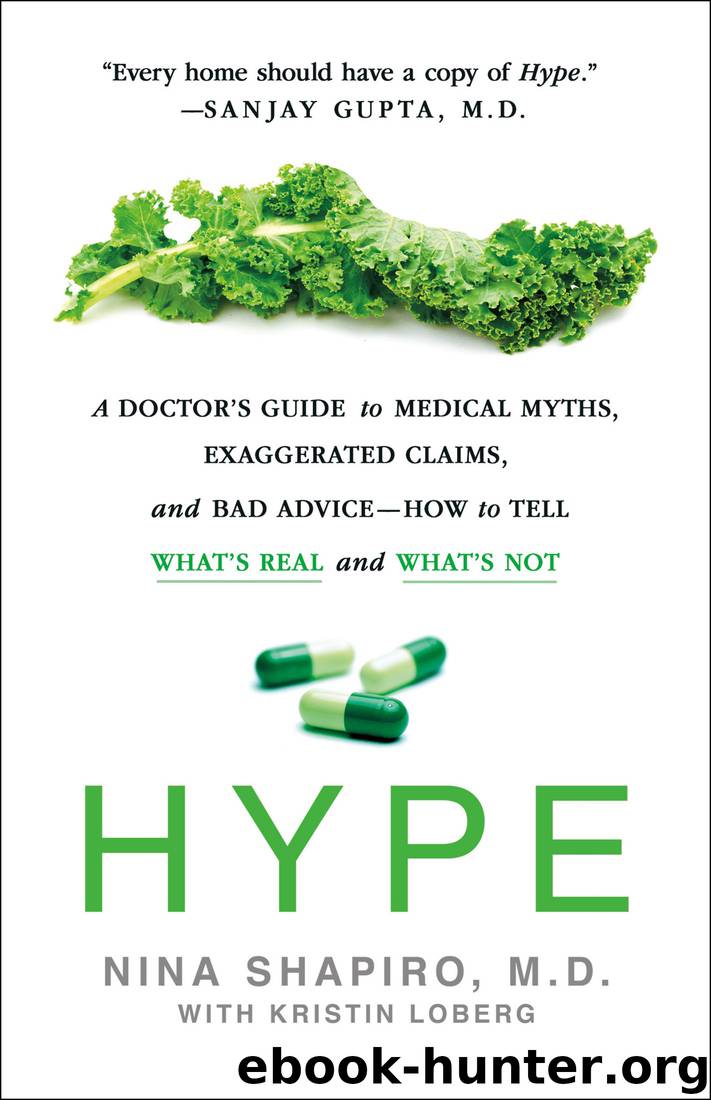Hype: A Doctor's Guide to Medical Myths, Exaggerated Claims, and Bad Advice - How to Tell What's Real and What's Not by Nina Shapiro & Kristin Loberg

Author:Nina Shapiro & Kristin Loberg
Language: eng
Format: epub
Tags: Health & Fitness, History, Life Sciences, Medicine & Health Sciences, Science
Publisher: St. Martin's Press
Published: 2018-05-02T03:00:00+00:00
CAFFEINATED
You don’t want to interact with me before I’ve had my morning coffee. I may not be such a great person afterward, but I’m pretty uninspired without it. Many people will say this about themselves. Caffeine is the most socially acceptable addictive drug on the market. Surgical training only made this more of a reality for me, and for so many others who function on too little sleep. It’s not that we’re superpowered after our cup of joe, but we’re pretty inert without it. And unlike alcohol or other drug addictions, caffeine addiction remains without social negativity. Nonetheless, it is a drug, and we’re addicted. That said, it’s not such a bad drug, and despite its addictive nature, our daily caffeine buzz can actually be to our advantage. Some studies have found habitual caffeine consumption to reduce risks of Alzheimer’s disease, Parkinson’s, and certain cancers. But it may be associated with increasing risk of bone loss and high blood pressure. Excessive caffeine intake during pregnancy—more than 300 mg per day—has even been associated with fetal loss.9
Despite ongoing studies, and multiple large population analyses, caffeinated-beverage consumption continues to be a mixed bag: it’s good for you; it’s bad for you. It stunts your growth; it helps you concentrate. Don’t drink caffeine while pregnant; it’s okay to drink caffeine while pregnant. While coffee continues to be the most commonly consumed caffeinated beverage, caffeine is present in sugary carbonated soft drinks, teas, energy drinks, sugary and fat-filled coffee and tea drinks (pass the mochaccino, please), and chocolate products. Adults tend to be the highest consumers of coffees and teas, and kids and teens are the ever-increasing drinkers of all of the other caffeinated treats. Even those that are not billed as such will likely contain some caffeine, sometimes even more than the products with the “energy” label. Have a headache? Take some Excedrin and you’ll get a bonus 65 mg of caffeine—nearly as much as in a good strong cup of coffee.
Eighty-five percent of the U.S. population, including children as young as age two, consume at least one caffeinated beverage per day. That’s right—two-year-olds drink caffeine-containing soda and chocolate drinks, and some are even given coffee. One cup of regular coffee contains approximately 95 mg of caffeine, and the daily consumption of up to 400 mg has been found to have no negative impact on health—it’s not necessarily good, but it’s not bad, either. For kids ages six to twelve, that drops down to 45–85 mg/day, and for pregnant women, 200 mg or less. So, yes, one (large) cup of regular coffee per day is fine for pregnant women. This is all according to the U.S. FDA recommendations. But they are not touting caffeine’s benefit; they are simply saying that it is not harmful.
One can of Red Bull contains 80 mg of caffeine, about as much as one cup of coffee.10 Caffeinated soda contains about 5 mg/ounce, but since servings are usually twelve ounces instead of eight ounces, each can packs about 60 mg of caffeine, almost as much as a cup of coffee.
Download
This site does not store any files on its server. We only index and link to content provided by other sites. Please contact the content providers to delete copyright contents if any and email us, we'll remove relevant links or contents immediately.
| Administration & Medicine Economics | Allied Health Professions |
| Basic Sciences | Dentistry |
| History | Medical Informatics |
| Medicine | Nursing |
| Pharmacology | Psychology |
| Research | Veterinary Medicine |
Good by S. Walden(3485)
The Social Psychology of Inequality by Unknown(2937)
0041152001443424520 .pdf by Unknown(2784)
The Checklist Manifesto by Atul Gawande(2776)
The Meaning of the Library by unknow(2504)
Guns, Germs and Steel by Diamond Jared(2303)
Borders by unknow(2227)
23:27 by H. L. Roberts(2195)
And the Band Played On by Randy Shilts(2127)
Get What's Yours for Medicare: Maximize Your Coverage, Minimize Your Costs by Philip Moeller(2088)
Being Mortal: Medicine and What Matters in the End by Atul Gawande(2081)
A Leg to Stand On by Oliver Sacks(2004)
The Hot Zone by Richard Preston(1983)
The Valachi Papers by Peter Maas(1810)
The Laws of Medicine by Siddhartha Mukherjee(1755)
The Andromeda Strain by Michael Crichton(1696)
The Obesity Epidemic by Robyn Toomath(1644)
Pharmacy Practice and The Law by Richard Abood(1541)
Autism's False Prophets by Paul A. Offit(1495)
